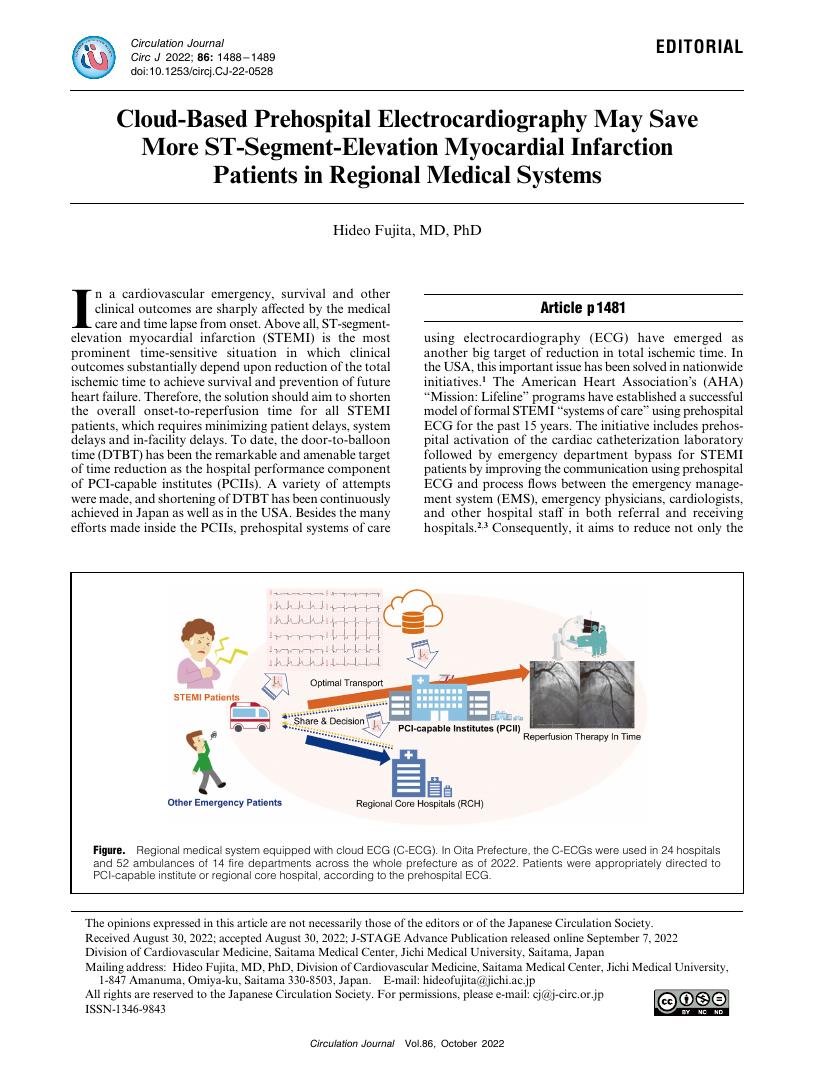- 著者
- Masataka Sato Satoshi Kodera Naoto Setoguchi Kengo Tanabe Shunichi Kushida Junji Kanda Mike Saji Mamoru Nanasato Hisataka Maki Hideo Fujita Nahoko Kato Hiroyuki Watanabe Minami Suzuki Masao Takahashi Naoko Sawada Masao Yamasaki Shinnosuke Sawano Susumu Katsushika Hiroki Shinohara Norifumi Takeda Katsuhito Fujiu Masao Daimon Hiroshi Akazawa Hiroyuki Morita Issei Komuro
- 出版者
- The Japanese Circulation Society
- 雑誌
- Circulation Journal (ISSN:13469843)
- 巻号頁・発行日
- pp.CJ-23-0216, (Released:2023-11-14)
- 参考文献数
- 41
- 被引用文献数
- 2
Background: Left heart abnormalities are risk factors for heart failure. However, echocardiography is not always available. Electrocardiograms (ECGs), which are now available from wearable devices, have the potential to detect these abnormalities. Nevertheless, whether a model can detect left heart abnormalities from single Lead I ECG data remains unclear.Methods and Results: We developed Lead I ECG models to detect low ejection fraction (EF), wall motion abnormality, left ventricular hypertrophy (LVH), left ventricular dilatation, and left atrial dilatation. We used a dataset comprising 229,439 paired sets of ECG and echocardiography data from 8 facilities, and validated the model using external verification with data from 2 facilities. The area under the receiver operating characteristic curves of our model was 0.913 for low EF, 0.832 for wall motion abnormality, 0.797 for LVH, 0.838 for left ventricular dilatation, and 0.802 for left atrial dilatation. In interpretation tests with 12 cardiologists, the accuracy of the model was 78.3% for low EF and 68.3% for LVH. Compared with cardiologists who read the 12-lead ECGs, the model’s performance was superior for LVH and similar for low EF.Conclusions: From a multicenter study dataset, we developed models to predict left heart abnormalities using Lead I on the ECG. The Lead I ECG models show superior or equivalent performance to cardiologists using 12-lead ECGs.
- 著者
- Hideo Fujita
- 出版者
- The Japanese Circulation Society
- 雑誌
- Circulation Journal (ISSN:13469843)
- 巻号頁・発行日
- vol.86, no.10, pp.1488-1489, 2022-09-22 (Released:2022-09-22)
- 参考文献数
- 9
- 著者
- Kenichi Sakakura Yousuke Taniguchi Mitsunari Matsumoto Hiroshi Wada Shin-ichi Momomura Hideo Fujita
- 出版者
- 一般社団法人 インターナショナル・ハート・ジャーナル刊行会
- 雑誌
- International Heart Journal (ISSN:13492365)
- 巻号頁・発行日
- pp.15-421, (Released:2016-05-09)
- 被引用文献数
- 20
Rotational atherectomy to an angulated calcified lesion is always challenging. The risk of catastrophic complications such as a burr becoming stuck or vessel perforation is greater when the calcified lesion is angulated. We describe the case of an 83-year-old female suffering from unstable angina. Diagnostic coronary angiography revealed an angulated calcified lesion in the proximal segment of the right coronary artery. We performed rotational atherectomy to the lesion, but intentionally did not advance the rotational atherectomy burr beyond the top of the angulation. We controlled the rotational atherectomy burr and stopped it just before the top of the angulation to avoid complications. Following rotational atherectomy, balloon dilatation with a non-compliant balloon was performed, and drug-eluting stents were successfully deployed. In this manuscript, we provide a review of the literature on this topic, and discuss how rotational atherectomy to an angulated calcified lesion should be performed.
- 著者
- Ichiro Takeuchi Hideo Fujita Kazuhiko Ohe Ryuta Imaki Nobuhiro Sato Kazui Soma Shinichi Niwano Tohru Izumi
- 出版者
- 一般社団法人 インターナショナル・ハート・ジャーナル刊行会
- 雑誌
- International Heart Journal (ISSN:13492365)
- 巻号頁・発行日
- vol.54, no.1, pp.45-47, 2013 (Released:2013-02-20)
- 参考文献数
- 13
- 被引用文献数
- 3 10
It is important for myocardial infarction patients to undergo immediate reperfusion of the affected coronary artery. In order to improve the prognosis, efforts to shorten the door to balloon time to within 90 minutes have been made. However, conventional methods such as faxing electrocardiograms (ECG) have not become widespread due to their high cost and lack of sharpness of the ECG. The “Doctor Car” (rapid response car system) of Kitasato University Hospital is now equipped with a Mobile Cloud ECG system. With this system, 12-lead ECG data obtained in the field are transmitted to the cloud server via a standard mobile telephone network. Since it uses an existing phone network, the cost of this system is low and it is fairly reliable. Cardiologists at the hospital read the ECG waveforms on the cloud server and decide whether emergency cardiac catheterization is necessary. In our fi rst case using this Mobile Cloud ECG system, the door to balloon time could be shortened.
